If you’re anything like me, you’re always on the hunt for ways to improve your hiking game. Whether you’re a seasoned pro or just starting out, there’s always room for improvement. In this article, I’ll share some of my top tips on how to hike better and with less effort.
Finding the Right Gear

Finding the right gear is a crucial step in your journey to becoming a better hiker. The right gear can make or break your hiking experience. So, let’s talk about some of the key elements.
An essential gear to start with is a good pair of hiking boots. You really do need to invest in a pair that’s sturdy, waterproof, and most importantly, comfortable. The last thing you want is to develop blisters halfway through your hike, trust me.
Proper clothing is next on the list. Layering is the way to go when dressing for a hiking trip. A moisture-wicking base layer, a warm mid-layer, and a waterproof outer layer should have you covered for most weather conditions. Remember, it’s easier to take off a layer if you’re hot, than to wish you’d brought more to wear if you’re cold.
A good backpack is essential. It should be able to comfortably carry all the necessities like water, food, first aid kit and extra clothing.
And there are a few key accessories you shouldn’t overlook:
- A hat and sunglasses for sun protection
- Maps and a compass for navigation
- A headlamp or torch just in case your hike goes on into the night
Not only will these items make your hikes more enjoyable, they’ll also ensure your safety on the trail. So take the time to carefully select your gear. It’s a bit of an investment, but it’ll surely pay off when your hiking experiences become far more enjoyable.
So now that we’ve got our gear covered, let’s move on to discussing the next step in enhancing your hiking skills.
Planning Your Route

The importance of a well-planned route can’t be overstated. It’s the roadmap that makes or breaks your hiking adventure. To a novice, this might sound daunting, but with good planning and foresight, it’s manageable.
First off, always research your trail. The world wide web is a trove of valuable resources for information on hiking trails. Look into factors like difficulty level, distance, and the approximate time it takes to complete the journey. You’ll want to clearly understand what you’re getting into before you lace up those hiking boots.
Don’t forget to check the weather forecast! Weather conditions can greatly affect your experience on the trail. Bad weather can turn a fun hike into a dangerous adventure with slippery trails, poor visibility, and potential for hypothermia. So, pick a day that promises clear skies and fair temperatures.
That said, don’t shy away from slight weather variations – hiking across different landscapes, in varying climates, and weather conditions adds to the overall hiking experience. Just make sure to pack appropriate gear to tackle the predicted weather and trail conditions.
In your backpack, always carry a map, compass, and a GPS device. While most trails are well marked, there’s always the off chance of losing your way. These tools will ensure you stay on track, even in unforeseen circumstances.
Choose loops over out-and-back trails. A loop doesn’t have me retrace my steps and offers new sights throughout the hike.
A key aspect of planning your route involves being familiar with potential hazards and understanding how to handle them. Be it slippery rocks, high altitudes or wildlife, anticipate these challenges and prepare accordingly.
Finally, remember to inform someone about your plans – your route, expected return time, and what they should do if you don’t return as planned. In the realm of hiking, it’s better to be safe than sorry.
Investing time in route planning is a surefire way to enhance hiking skills, make journeys safer and more enjoyable. So let’s move on to the next intriguing aspect of hiking: establishing a proper pace.
Mastering the Basics of Hiking
After you’ve got the planning part down, it’s time to set the proper pace. Establishing a good pace is a crucial step towards mastering the art of hiking. Moving too quickly over rough terrain can lead to injuries, while a pace that’s too slow may put you behind schedule.
Here are some tips to nail the pace game:
- Start slow: Take your time, especially at the beginning of the trail. That’s when I recommend taking frequent breaks. Let your body adjust to the new environment, you’ll gradually gain momentum.
- Maintain a steady rhythm: Consistency is the key. Even if you’re moving slow, keeping a steady pace is more effective than intermittent fast and slow walking. Remember, it’s not a race.
- Listen to your body: If you’re feeling tired, it’s okay to stop. Rest, drink water, fuel your body with some snacks before getting back on the path. Your body’s signals are never to be ignored.
Once you’ve got the pacing right, the next step is to focus on balance. Trekking over varied terrains can often put your balance to the test. You may encounter steep inclines or rocky paths. To prevent falling or tripping, use trekking poles. It’s a proven method adopted by hikers worldwide.
Remember:
- Position your body correctly: Lean slightly forward when you’re ascending and slightly backward during descent. This posture provides the right balance and reduces strain on your knees.
- Watch where you step: Keep your eyes on the trail. Stay vigilant for branches, loose rocks or anything that might trip you up.
Hiking isn’t just about reaching the destination, it’s about embracing the journey. So don’t rush, soak in the environment, and take breaks as needed. The trail will always be there.
Let me now reveal another secret of mastering hiking – understanding the trail marking system. But that’s a topic for the next section.
Improving Your Physical Fitness

Remember, hiking is an engaging, full-body workout. It’s not just about the feets, it’s about endurance, strength, and flexibility. To ensure that you are hiking to the best of your ability, one must consider boosting their overall physical fitness level.
Strength Training
Focus on incorporating regular strength training exercises into your routine. It should involve major muscle groups particularly legs and core. When hiking, you depend on these muscle groups to remain steady on uneven terrain and carry your pack.
- Squats
- Lunges
- Deadlifts
These are prime examples of full body exercises that can assist with hiking performance. I’d recommend at least two days of strength training each week to see real gains.
Cardiovascular Fitness
Next, work on your cardiovascular fitness. Hiking can be a real heart-pumping adventure, getting your blood flowing and your lungs demanding more. To prepare, include activities like brisk walking, running or cycling in your workout routine. A solid target is to have some form of cardio exercise for around 30 minutes a day, five days a week.
Balance and Flexibility
Another key aspect is training for balance and flexibility. Regular stretching and balance-focused workouts like yoga or Tai Chi can help. These will enhance your ability to navigate slippery stones, high steps, and switchbacks often found in hiking trails.
Every journey begins with one step, and hiking is no different. It’s crucial to embrace the physical demands and gear up your body accordingly. But similarly important is understanding and reading the trails better. Let’s take a look in the following section about how to understand the trail marking system more efficiently.
Enhancing Your Hiking Skills

After discussing how physical fitness can significantly improve your hiking experience, it’s now time to delve into how to further enhance your hiking skills. Mastering the fundamentals can take your treks from average to outstanding – an aim every hiking enthusiast should have.
One of the most crucial skills to learn in hiking is navigational prowess. It doesn’t matter if you’re hiking a well-marked trail or venturing into the unknown – understanding maps, compasses, GPS systems, and the natural landmarks around you is highly valuable. You’d also want to understand the nuances of different trail marking systems. If you’re in Europe for instance, the usage of red and white stripes might be common.
The ability to forecast and cope with the diverse weather patterns that you might come across during a hike shouldn’t be underestimated. As you know, unpreparedness in the face of bad weather can turn a lovely trip into a dangerous ordeal. Ensure you pack right, have an emergency plan, and know when to turn back if conditions become too adversarial.
Next, let’s turn our attention to first aid skills. No matter the length or difficulty of your hike, injuries might come uninvited and unexpected. Knowing basic wound care, treatment for sprains and breaks, or how to manage sudden illness can save a hike or even a life. Certifications in wilderness first aid courses come highly recommended for serious hikers.
Lastly, you must master the art of pack packing. Ensuring you’ve got all the necessary gear but maintaining a manageable weight is a balance that needs practice. Choose a pack of the right size, distribute weight evenly, and learn how to discard non-essential items. The intersection of utility and necessity is where you want to be.
From understanding navigation to dealing with emergencies, honing these skills can drastically improve your hiking experience. As you continue to explore the trails, be mindful of these tips and don’t shy away from learning new ones.
Conclusion: How to Hike Better
So, we’ve explored the ins and outs of hiking. It’s clear that a successful hike isn’t just about the physical exertion. It’s about being prepared, understanding your surroundings, and having the right skills.
Mastering navigation is key. Whether it’s maps or compasses, GPS or trail markings, knowing your way around is crucial. It’s not just about getting from point A to B. It’s about enjoying the journey and staying safe.
Weather is another factor that can’t be ignored. It’s unpredictable and can change in an instant. Being able to anticipate and adapt to these changes can make or break your hiking experience.
Lastly, let’s not forget the importance of first aid knowledge and efficient pack packing. They may seem minor but can have a big impact on your hike.
So there you have it. It’s not just about putting one foot in front of the other. Hiking is a skill, and like any skill, it can be improved.

